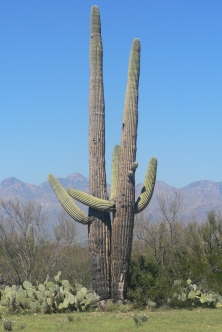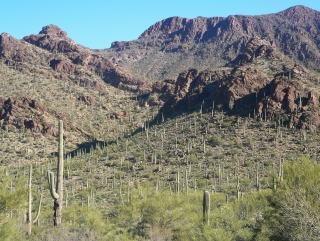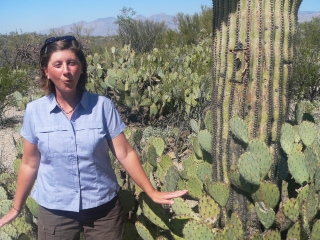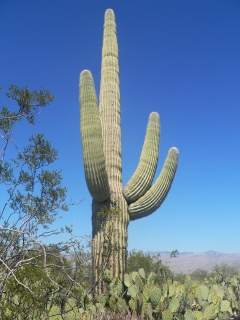NPS Website; Tucson Mountain Park Website
 WHAT IS IT?
WHAT IS IT?Two Parks, Saguaro East and Saguaro West, that together total 91,327 acres of protected Sonoran Desert landscape and a startling number of the distinctive, human-like saguaro (pronounced suh-WAHR-oh) cacti. The Parks serve as effective bookends to the increasing urban sprawl of Tucson, Arizona.
A short hike in Saguaro West, just off the loop road, on the Signal Hill Petroglyphs Trail gives a close look of hundreds of ancient rock carvings.
BEAUTY (8/10)
Sure, anywhere you drive in southern Arizona you will see saguaro cacti. Front lawns, mall parking lot medians, along the roadside, etc… But mostly, they are a novelty, an urban adaptation, a reminder that we have conquered the desert.
Once you leave the never-ending Tucson city limits and enter the National Park or Tucson Mountain Park, the cacti are no longer isolated. They stand in a forest, dotting the landscape as far as the eye can see.
Stare for a little bit and they exude complex and intricate patterns and beauty. Stare for too long and they become human, arms extended in welcoming, confrontational and shiva-esque directions. The cacti take on individual personalities, moods and strengths. Some local Indian tribes believe the cacti hold the souls of the dead. Their belief is easy to understand.
Saguaro NP is not located on a flat desert landscape, as Michael had always imagined. In Sagauro East, the Park extends up to the mixed Conifer Forest of Mica Mountain, an elevation gain of nearly 6,000 feet. Hikes in this area will bring a welcome respite from the stifling Arizona summer heat.
Saguaro West’s visual drama comes not from rising altitudes and ecological change but from the saguaro cacti themselves. Saguaro West saw less cattle grazing and human incursion than its National Parks partner. As a result, the saguaros, which lives and grow for over 150 years, are taller, closer together and sprout more arms.
HISTORICAL INTEREST (4/10)
Without the land set aside for public use, Saguaro NP, Coronado National Forest and Tucson Mountain Park, Tucson would go on forever in all directions, resembling Phoenix or even Los Angeles. Instead, the city enjoys world-class recreational opportunities and consistently ranks as one of the top 10 cities to live in in the United States.
 CROWDS (5/10)
CROWDS (5/10)The Park’s proximity to Tucson brings lots of people. The Parks’ two loop drives consist of only one lane and Saguaro West’s loop drive is unpaved. For the most part, cars creep along the roads in a steady single file manner, pulling over frequently to take yet another saguaro cactus picture. We did encounter one or two aggressive drivers racing through a National Park loop drive, (why did they even come?) but they were the exception rather than the rule. Do be careful of bicyclers in Tucson East.
EASE OF USE/ACCESS (5/5)
One Park is on the eastern edge of Tucson (Interstate 10 exits 275 or 279), the other is at the city’s western limit (Interstate 10 exits 242 or 257). There are plenty of signs.
CONCESSIONS/BOOKSTORE (4/5)
Both sections of the Park have a terrific selection of desert-related merchandise and books. Saguaro West’s bookstore has a much larger space and is easier to navigate. We were tempted to buy so many different things, ranging from Mark Reisner’s book on water use in the American West, Cadillac Desert to a charming stuffed coyote doll to gingerbread mix with a javelina-shaped cookie cutter. Other interesting things included iron-on petroglyph t-shirt designs, desert flower notecards and a few books about healing with native plants.
COSTS (2/5)
Park entry is $10 per car or free with the National Parks Pass. Tucson Mountain Park, located just south of Saguaro West (and containing the same landscape) is free. There are no car accessible campgrounds in Saguaro NP. Backcountry camping is allowed on in Saguaro East and in the designated campsites. Make reservations for these hike-in spots, they fill up quickly.
 You can car camp at Tucson Mountain Park’s Gilbert Ray campground for $10 a night. More than a few people recommended the site, adding that the bird-watching is among the best in the southwest.
You can car camp at Tucson Mountain Park’s Gilbert Ray campground for $10 a night. More than a few people recommended the site, adding that the bird-watching is among the best in the southwest.RANGER/GUIDE TO TOURIST RATIO (4/5)
Given the droves of visitors, there could have been more Rangers helping out at the information desk. But heck, there are lots of tours and we had no trouble getting any of our Saguaro questions answered.
TOURS/CLASSES (7/10)
Both West and East offer a plethora of Interpretive Ranger-led programs. Saguaro East had 25 talks during the week of our visit and Saguaro West offered at least 19. The talks range from 30-minute talks on Desert Adaptations to 3-hour morning desert hikes.
The film and Museum is far superior in Saguaro West. East still has a Mission ’66-era museum and its film is a boring tale of what you can do in the Park. Saguaro West has a terrific slide slow whose end literally beckons you into the desert. The screen reels up, curtains recede and ceiling high windows show you the beautiful outdoor landscape. We were inspired.
FUN (7/10)
Gab isn’t a big fan of the desert. Just ask her about Death Valley. But Saguaro NP felt full of life. To drive the Saguaro East loop road is to watch symbiotic relationships flourish all around you. Cactus wrens are busy building nests in every cholla. Gila woodpeckers and gilded flickers make their marks on all the Saguaros, giving facial features to giants that already look near human.
What did we do at Saguaro? The same things everyone else did. Drove the loop roads, jumped out of the car to take pictures, walked the nature trails, stood in front of cacti and tried to mimic their poses. It was fun to be in the midst of so many people finding joy in the wilder regions of Arizona just outside the sprawl of the city.
If you are looking for more solitude, a hike into the Rincon Mountains or along the Tanque Verde Ridge will take you away from the crowds. We enjoyed the short self-guided nature trails along each loop drove, convincing ourselves that it was too hot to start a longer hike.
Not that the heat and sun didn’t feel fantastic. If you are looking for something to cure your winter blues, a trip to Saguaro NP might do it.
 WOULD WE RECOMMEND? (8/10)
WOULD WE RECOMMEND? (8/10)The saguaro cactus is an iconic image of the American southwest. It is very familiar to our imagination. Seeing forests of the majestic cactus is such a different and wonderful experience. Which Saguaro park should you visit? That is a tough one. Here are some comparative differences.
Saguaro West: more cacti; taller cacti; near the popular Arizona-Sonora Desert Museum (actually a desert zoo); near the Old Tucson Studios park; you can camp at Gilbert Ray campground nearby; terrific film; lots of short Ranger talks offered; more space inside; petroglyphs; unpaved loop road.
Sagauro East: more diverse ecosystems; ability to take multi-day hikes into the mountains; backcountry camping available; paved loop road; longer loop road; many more acres and more miles of hiking trails.
We never imagined that two sections of one National Park dedicated to one type of cactus could be so different. Regardless, both are wonderful places and Tucson, Arizona is a nice winter vacation spot. We loved the 90º weather and $4 spring training baseball. Just remember that while you are in town there is a great National Park on the outskirts.
TOTAL 54/80
www.usa-c2c.com
© 2004-06